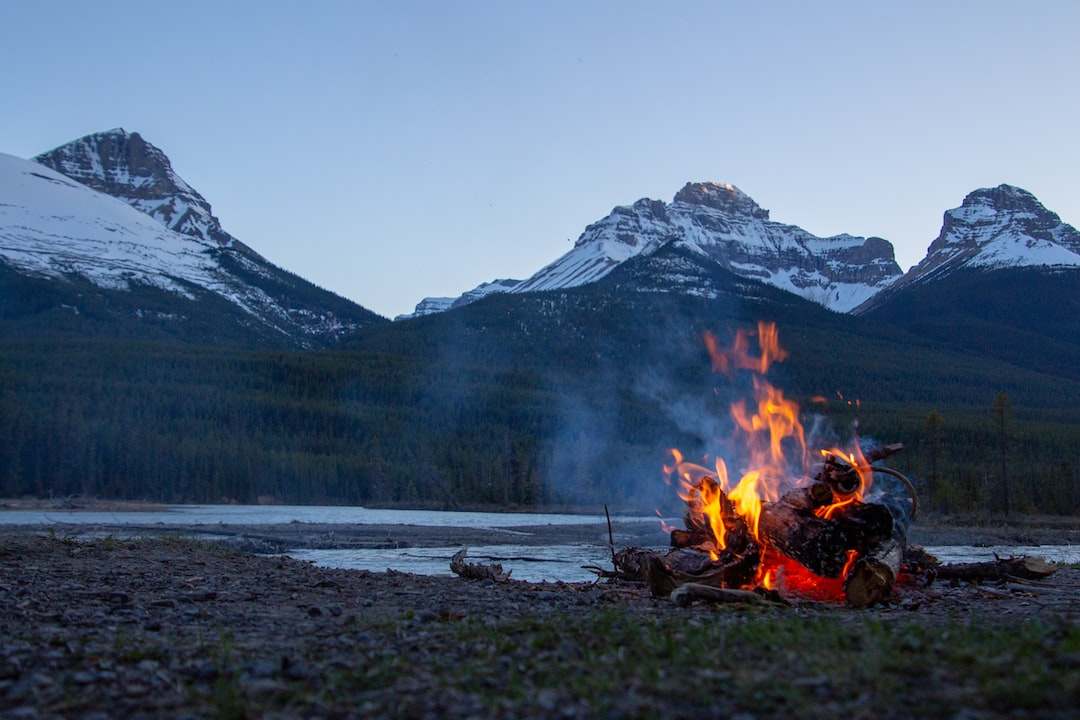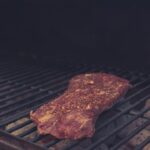Although wet weather may present a challenge, starting a fire in the rain is achievable with proper preparation and knowledge.
Gearing up with the right items and understanding how to light a fire in wet weather will demonstrate that even when conditions are damp, your outdoor adventures don’t need to be cut short.
In this article we will cover everything you need for starting a fire in rainy weather – from gathering supplies such as dry wood or DIY starters, finding suitable locations for fires, preparing the pit correctly and maintaining your flame when things get wet.
So if you’re ready to learn how to start a fire in the rain then let’s get started.
Gather the Necessary Supplies
When it comes to gathering the necessary supplies for starting a fire in the rain, there are four key items that you’ll need: firewood, tinder, kindling and matches or a lighter.
Firewood is essential for providing fuel to keep your fire going; make sure to gather enough of it so that your flame doesn’t die out.
Tinder is used as an igniter; small twigs and leaves work best here because they catch onto the spark quickly.
Kindling should be gathered too – sticks no thicker than a pencil are ideal – as this will help get your flame started and burning steadily.
Lastly, having either matches or a lighter on hand will help you light up all of these materials easily without having to resort to other methods like friction-based techniques which can take more time and energy when wet conditions are present.
With all these supplies ready before attempting any sort of ignition, you can rest assured knowing that your outdoor experience won’t be cut short due to lack of preparation.
Gathering the necessary supplies for starting a fire in the rain is an important first step. Now, pick a spot to construct your blaze with the collected supplies.
Choose a Suitable Location
When starting a fire, select an appropriate spot with dry ground and wind protection for the best chance of success.
Dry ground and wind protection are essential for keeping your fire burning. Look for an area that is free of standing water or damp soil as these can make it difficult to get your fire going.
Dry Ground:
Make sure the ground you choose is dry enough so that any sparks won’t be extinguished by moisture on the ground.
If possible, look for areas with some natural cover such as trees or rocks which will help keep your fire sheltered from the elements. It’s also best to stay away from low-lying areas where water might pool up during heavy rains.
Attempt to locate a spot that offers some respite from gusts of air, as these can quickly snuff out a small flame. You can create a makeshift windbreak using logs or large rocks around your campfire site; this will help protect against sudden gusts of wind and ensure that your flames don’t die out too easily when things start getting breezy outside.
Additionally, positioning yourself behind something like a rock wall or tree trunk can provide additional protection against strong winds while still allowing you access to tend the fire safely without having to move around too much in potentially slippery conditions.
When selecting a suitable location for starting a fire in the rain, be sure to choose an area with dry ground and some form of wind protection. Now that you have chosen your spot, it is time to prepare the fire pit by clearing debris and leaves as well as digging a trench around the pit.
Prepare the Fire Pit
Preparing the fire pit is an essential part of any successful hunting trip. It’s important to make sure that your fire is contained and won’t spread into nearby vegetation or buildings. Clear the ground around where you plan to set up your fire by removing any debris or foliage.
This will ensure that there are no flammable materials close by which could potentially ignite during use.
Digging a trench around the pit can also help contain sparks or embers which may escape during use. The trench should be at least 6 inches deep in order to provide enough protection against any errant sparks or embers that might fly out of the pit when it’s being used for cooking or warmth.
You can also add rocks or logs around the perimeter of the pit as an additional layer of protection against spreading flames and smoke.
Finally, it’s important to make sure that all combustible materials such as dry leaves, sticks, twigs, etc., are kept far away from your campfire while in use so they don’t catch alight accidentally due to flying sparks or embers escaping from the firepit itself. By taking these simple precautions before lighting up a campfire, you will be able to enjoy a safe and enjoyable experience while out hunting in rural western United States.
Preparing the fire pit is essential to having a successful fire in any weather condition. To ensure that your fire will start and stay lit, it’s important to create a windbreak with rocks or logs around the pit before attempting to light it.
Start the Fire in Rainy Conditions
When using waterproof matches or lighters, make sure to keep them dry until ready for use. It is also important to create a windbreak with rocks or logs so that gusts of wind won’t blow out your flame. This will help ensure that your fire stays lit even in wet weather.
When creating the windbreak, place the rocks or logs around the perimeter of your fire pit so that any incoming winds are blocked from reaching it directly. The height and thickness of these objects should depend on how strong you expect the winds to be; if they are particularly strong, consider adding more layers of protection such as tarps or blankets between the rocks and logs for extra insulation against gusts of air.
Additionally, try to angle these objects towards each other at an angle as this will further block out any potential drafts from entering your campfire area.
It is also important to monitor your fire during rainy conditions by keeping an eye on both smoke levels and sparks which could potentially ignite nearby combustible materials such as leaves or branches.
To prevent this from happening add additional fuel periodically throughout its duration – this will help keep it burning brightly without allowing too much smoke buildup which can indicate a lack of oxygen being supplied to sustain combustion properly.
Finally, when all else fails and you just need some extra heat while outdoors in inclement weather, build a makeshift shelter over top of your fire pit. This will protect it from raindrops while still providing enough airflow for combustion purposes; however make sure not to block off too much air otherwise you risk suffocating what little flame remains due to insufficient oxygen supply.
Starting a fire in rainy conditions can be done with the right materials and techniques. With proper monitoring and fuel, maintaining the fire will help keep it burning even in wet weather.
Maintain and Monitor the Fire in Rainy Conditions
When it comes to maintaining and monitoring a fire in rainy conditions, safety is of the utmost importance. To keep your fire burning, you must add fuel regularly. This will help prevent it from going out due to rain or wet wood.
When adding fuel, be sure to use only dry materials that won’t cause an increase in smoke production or sparks that could spread beyond your designated area of containment. Additionally, monitor for any smoke or sparks that may escape the confines of your campfire pit. If flames spread, quickly act by either dousing with water or covering in soil until totally put out.
Before venturing out in inclement weather, be sure to have waterproof matches or lighters and dry tinder, kindling, and firewood on hand. Make sure you have waterproof matches or lighters handy so you can start a fire even when everything else around you is damp and wet.
Additionally, gather tinder such as paper towels and twigs; kindling like small branches; and plenty of dry firewood before setting up camp for added convenience if needed later on down the line after getting caught in an unexpected storm system while out in nature enjoying all its beauty.
FAQs in Relation to How to Start a Fire in the Rain
How do you start a fire in the rain?
To start a fire in the rain, you need to create a shelter around your kindling and fuel. Gather dry tinder such as bark shavings, leaves or grass and stack them under an overhanging rock or tree branch. Use waterproof matches if available. If not, use flint and steel with char cloth for sparks.
Once the flame is established, add small twigs then gradually increase size of wood until desired heat is reached. To keep it burning longer build up the sides of your shelter so that wind won’t blow out the flame.
Can a fire exist in the rain?
Yes, a fire can exist in the rain. It is possible to create and maintain a fire even when it is raining if the conditions are right. The most important factor for success is having enough fuel that will not get wet from the rain.
Wind, fuel kind, spot of fire and use of tarp or other coverings are all important in deciding if a successful flame can be made while raining. With proper knowledge and preparation, creating a safe and effective campfire while it’s raining is achievable.
How do you keep a fire alive in the rain?
To keep a fire alive in the rain, you must first construct an enclosure around it using materials that are waterproof and windproof.
Construct a covering atop the fire’s shelter to shield it from precipitation or snowfall. Make sure there is enough ventilation so that air can circulate inside the shelter.
Finally, add fuel such as dry wood or charcoal to maintain heat and ensure your fire will stay lit even during wet conditions.
How do you like a campfire in the rain?
I enjoy a campfire in the rain, as it adds to the atmosphere and experience of being outdoors. The sound of the rain creates a unique ambiance that is hard to replicate elsewhere. It also provides an opportunity for people to come together and bond over stories around the fire while still enjoying nature’s beauty.
A campfire in the rain can be especially enjoyable when accompanied by warm drinks or snacks, allowing everyone present to relax and take pleasure in their surroundings despite any inclement weather.
Conclusion
Gather all necessary materials such as dry wood, tinder, and kindling before you begin your journey. Choose an area that will protect your fire from wind or other elements while also providing access to water if needed. Preparing a fire pit correctly is essential for keeping flames alive during wet weather conditions.
Finally remember to maintain and monitor the fire throughout its life cycle so that you have control over when it starts or stops burning – even in rainy weather. With these tips in mind starting a successful blaze no matter what Mother Nature throws at us should be achievable every time.



